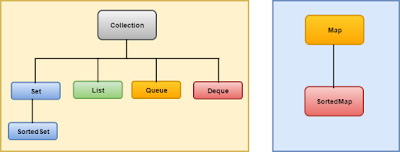Collection Interfaces
The core collection
interfaces encapsulate different
types of collections. These interfaces allow collections to be manipulated
independently of the details of their representation. Core collection
interfaces are the foundation of the Java Collections Framework.
The following describes the core
collection interfaces:
- Collection — Collection
is the root of the collection hierarchy. A collection represents a group
of objects known as its elements. Some types of collections allow
duplicate elements, and others do not. Some are ordered and others are
unordered. The Java platform provides implementation of more specific sub
interfaces like Set and List and doesn't provide any direct
implementations of Collection interface.
- Set — Set is a collection that
cannot contain duplicate elements.
- List — List is an ordered
collection. Lists can contain duplicate elements.
- Queue — Queue is a collection
used to hold multiple elements prior to processing.
- Deque — Deque is a collection
used to hold multiple elements prior to processing. In a deque all new
elements can be inserted, retrieved and removed at both ends.
- Map — Map is an object that
maps keys to values. A Map cannot contain duplicate keys; each
key can map to at most one value.
- SortedSet — SortedSet
is a Set that maintains its elements in ascending order.
- SortedMap — SortedMap is
a Map that maintains its mappings in ascending key order.
The Collection interface
contains methods that perform basic operations, such as
·
int size()
·
boolean isEmpty()
·
boolean contains(Object
element)
·
boolean add(E element)
·
boolean remove(Object
element)
·
Iterator<E>
iterator()
It
also contains methods that operate on entire collections
·
boolean
containsAll(Collection<?> c)
·
boolean
addAll(Collection<? extends E> c)
·
boolean
removeAll(Collection<?> c)
·
boolean
retainAll(Collection<?> c)
·
void clear().
Traversing Collections
There
are three ways to traverse collections
1.
using aggregate operations
2.
using the for-each
construct
3.
using Iterators
Aggregate Operations
In
JDK 8 and later, the preferred method of iterating over a collection is to
obtain a stream and perform aggregate operations on it.
Aggregate
operations are often used in conjunction with lambda expressions to make
programming more expressive, using less lines of code.
The
following code sequentially iterates through a collection of Employees and
prints out the Name of Employee of HR department
myEmployeeCollection.stream()
.filter(e -> e.getDepartment() == “HR”)
.forEach(e -> System.out.println(e.getName()));
The
for-each construct allows you to concisely traverse a collection or array using
a for loop.
The
following code uses the for-each construct to print out each element of a
collection on a separate line.
for (Object o : collection)
System.out.println(o);
Iterators
An
Iterator is an object that enables you to traverse through a collection and to
remove elements from the collection selectively.
You
get an Iterator for a collection by calling its iterator method. The following
is the Iterator interface.
public interface Iterator<E> {
boolean hasNext();
E next();
void remove(); //optional
}
The
hasNext method returns true if the iteration has more elements, and the next
method returns the next element in the iteration.
The
remove method removes the last element that was returned by next from the
underlying Collection.
 |
Collection Interfaces
|
No comments:
Post a Comment